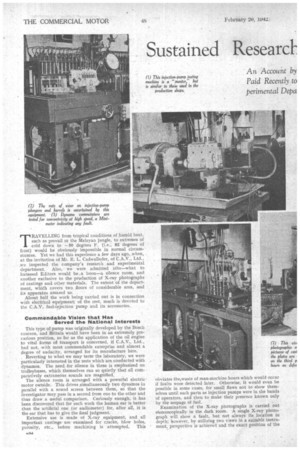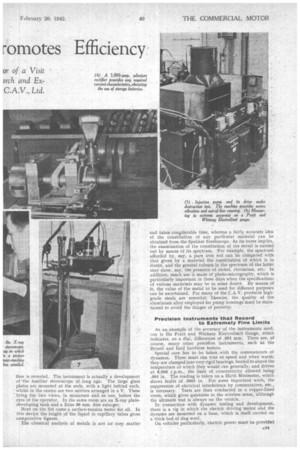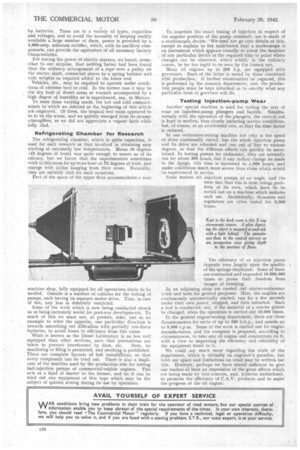Sustained Researdc romotes Efficiency
Page 26

Page 27

Page 28

If you've noticed an error in this article please click here to report it so we can fix it.
An Account by Paid Recently to perimental Depa or of a Visit trch and aC.A.V., Ltd.
TRAVELLING from tropical conditions of humid heat, such as prevail in the Malayan jungle, to extremes of cold down to —50 degrees F. (i.e., 82 degrees of frost) would be obviously impossible in normal circumstances. Yet we had this experience a few days ago, when, at the invitation of Mr. E. L. Cadwallader, of C.A.V., Ltd., .we inspected the. company's research and experimental department. Also, we were admitted irito—what to harassed Editors would be .a, boon—a silence room, and another exclusive to the production of •X-ray photographs of castirrgs and, other materials. The extent of the department, which covers two floors of considerable area, and its apparatus amazed us. ,
About half the work being carried out is in connection with electrical equipment; of the rest, much is devoted to the C.A.V. fuel-injection pump and its accessories, Commendable Vision that Has Served the National Interests This type of pump was originally developed by the Bosch concern, and Britain would have been in an extremely precarious position, so far as the application of the oil engine to vital forms of transport is concerned, if C.A.V., Ltd., had not, with most commendable enterprise and almost a degree of audacity, arranged for its manufacture here.
, Reverting to what we may term the laboratory, we were particularly interested in the tests which are, conducted with dynamos. The need for silence in these is emphasized on trolleybuses, which themselves run so quietly that all comparatively extraneous sounds are magnified.
The silence room is arranged with a powerful electric motor outside.. This drives simultaneously two dynamos in parallel with a sound screen between them, so that the investigator-may pass in a second from one to the other and thus draw a useful comparison. Curiously enough, it has been discovered that for such work the human ear is better than the artificial one (or audiometer) for, after all, it is the ear that has to give the final judgment.
Extensive use is made of X-ray equipment, and all important castings are examined for cracks, blow holes, porosity, etc.. before machining is attempted. This obviates theovaste of man-machine hours which would occur if faults were detected later. Otherwise, it would even be • possible in some cases, for small flaws not to show themselves until such parts as injection pumps were in-the hands of operators, and then to make their presence known only by the seepage of fuel. Examination of the X-ray photographs is carried out stereoscopically in the dark room. A single X-ray photo• graph will shoW a fault, but not always its location in depth; however, by utilizing two views in a suitable instrument, perspective is achieved and the exact position of the flaw is revealed, The instrument is actually a development of 'the familiar stereoscope of-long ago. The large glass plates are mounted at the ends, with a light behind each, whilst in the centre are two mirrors arranged in a V. These bring the two views, in miniature and as one, before the eyes of the operator. In the same room are an X-ray platedeveloping tank and a Zeiss 36 mm. film enlarger. Next on the list came a surface-tension tester for oil. In this device the height of the liquid in capillary tubes gives comparative figures.
The chemical analysis of metals is not an' easy, matter
and takes coN,iderable time, whereas a fairly accurate idea of the constitution of any particular material can be obtained from the Spekker Steeloscope. As its name implies, the examination of the constitution of the metal is carried Out by means of its spectrum, For example, the spectruni afforded by, say, a pure iron rod can be compared with that given by a material the constitution of which is in doubt, and the general colours in the spectrum of the latter may show, say, the presence of nickel, chromium, etc. In addition, much use is made of photo-micrography, which is particularly important in these days when the specifications of various materiels may be in some doubt. By means.of it, the value of the metal to be used for different purposes can be ascertained. For many of the C.A.V. products highgrade steels are essential; likewise, the quality of the aluminium alloy employed for pump housings must be maintained to avoid the danger of porosity.
Precision Instruments that Record to Extremely Fine Limits As an example of the accuracy of the instruments used, (vie is the Pratt and Whitney Electrolimit Gauge, which indicates, on a dial, differences of .001 mm. There are, of course, many other precilion instruments, such as the Brinell and Izocl hardness testers.
Special care has to be taken. with the commutators of dynamos. These must ran true at speed and when warm; they are clamped into very rigid bearings, heated to above the temperature at which they would run generally, and driven at 6,000 r.p.m., the limit of concentricity allowed being .001 in. The reading is taken on a Hirth Minimeter, which shows faults of .0001 in. For some important work, the suppression of electrical interference by commutators, etc., is necessary. Tests are then conducted in a copper-lined room, which gives quietness in the wireless sense, -although the ultimate test is always on the vehicle. • In connection with dynamo testing and development, there is a rig in which the electric driving 'motor arid the dynamo are mounted on a base, which is itself carried on a thick bed of slag wool.
On vehicles particularly, 'electric power must be provided
by batteries. These are in a variety of types, capacities and voltages, and to avoid the necessity of keeping readily available a large number of them, power is provided by a 3,000-amp. selenium rectifier, which, with its ancillary components, can provide the equivalent of all necessary battery characteristics.
For testing the power of electric starters, we learnt, somewhat to our surprise, that nothing better had been found than the ordinary arrangement of a rope over a pulley on the starter shaft, connected above to a spring balance and with weights as required added to the lower end.
Vehicles, etc., may be required to operate under conditions .of extreme heat or cold. In the former case it may be the dry heat of desert areas or warmth accompanied by a high degree of humidity as is experienced, say, in Malaya.
To meet these varying needs, the hot and cold compartments to which we referred at the beginning of this article are employed. Of these, the tropical test room appeared to us to be the worse, and we quickly emerged from its steamy atmospliere, as we did not appreciate a vapour bath while fully clad.
Refrigerating Chamber for Research The refrigerating chamber, which is quite capacious, is used for such research• as that involved in obtaining easy starting at extremely low temperatures. Minus 10 degrees (42 degrees of frost) was quite enough to assure us of its efficacy, but we learnt that the experimenters sometimes work in this room for up to an hour at 72 degrees of frost, and emerge with icicles hanging from their noses. Naturally, they are suitablY clad for such occasions. • Part of the space of the upper floor accommodates a neat
machine shop, fully equipped for all operations likely to be needed. Outside is a number of cubicles for the testing of pumps, each having its separate motor drive. Thus, in case of fire, any loss is definitely restricted.
Some of the work which is now being conducted struck us as being extremely useful for post-war developments. To much of this we must not, at present, refer, but as an example to whet the appetite, one particular direction is towards smoothing out difficulties with partially run-down batteries, to avoid losses in efficiency from this cause.
What is known as the Diesel Laboratory is no less wellequipped than other sections, save that precautions are
taken to prevent interference by dust, etc. Here, no machining or filing is permitted, and smoking is prohibited. There are complete layouts of fuel installaTions, so that every component can be tried out. There is also a duplicate of the machine used by theproduction side for testing fuel-injection pumps of commercial-vehicle engines. This acts as a kind of master to the former, and on it can be tried out any equipment of this type which may be the subject of queries arising during its use by operators.
To asc.ertain the exact timing of injection in respect of the angular position of the pump camshaft, use is made of a stroboscopicdevice. We-need not go into details of this, except to explain to the uninitiated -that a Stroboscope is an instrument which appears visually to arrest the function of any particular device at the required time-or 'point Where changes can be observed, which would, in the ordinary course, be far too rapid to be seen by the human eye.
Many oil engines up to 200 h.p are equipped with governors. Each of the latter is tested by those concerned with production. If further examination be required, this is performed by the research department; also, the production people must be kept informed as to exactly what any particular form of governor will do.
Testing Injection-pump Wear
Another special machine is used for testing the rate of wear on injection-pump plungers and barrels. Simultaneously with the operation of the plungers, the control rod is kept in motion, thus closely imitating service conditions, but, of course, at an accelerated rate, so that the time factor is reduced.
In one endurance-testing machine not only is the speed of drive continually varied, but the whole injection pump and its drive are vibrated and run out of line to various degrees, so that the different effects can quickly be ascertained. In testing pumps for endurance, they are normally • run for about 500 hours, but if any radical change be made in the dRsign, this time is increased to -1,000 hours, and under conditions much more severe than those which would he experienced in service.
Some makers set injection pumps at an angle, and the mere fact that this is done brings prob lems of its own, which have ;to be sorted out on a machine which imitates such use. Incidentally, dynamos and regulators are often tested for 5,000 hours.
The efficiency of an injection pump depends very largely upon the quality of the springs employed, Some of these are contracted and expanded 10,000,000 times to prove their ,freedom from danger of breaking.
" In an adjoining shop are carried out starter-endurance trials and tests for general purposes. Here, the engines are continuously automatically started, run for a few seconds under their own power, stopped, and then restarted. Such a test is conducted, say, if the material of a starter pinion be changed, when the operation is carried out 10,000 times.
'In the general engine-testing department, there are three dynamometers for units of up to 350 b.h.p., and speeds up to 5,000 r.p.m. Some of the work is carried out for engine manufacturers, and the company is prepared, according to cireumsta.nces, to take any oil engine and concentrate on it, with a view to improving the efficiency and reliability of the equipment fitted to it.
We could say much more regarding the work of the department, which is virtually an engineer's paradise, but both our space and limitations on what may be written bar this. However, perhaps we have stated sufficient to give our readers at least an impression of the great efforts which are being made 1..)37 this concern, and, hitherto undisclosed, to promote the efficiency of C.A.V. products and to assist the progress of the oil engine.




















































